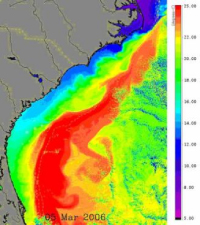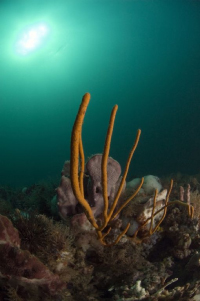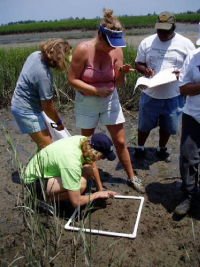 | |
|
COSEE SE serves North Carolina, South Carolina and Georgia. Our charge is to increase interactions between the ocean sciences and education communities, and to provide initiatives that will improve science education and focus on our regional ecosystems. The three states have similar shorelines, though their respective lengths are dramatically different! North Carolina has approximately 350 miles of shoreline, South Carolina has about 150 miles and Georgia has about 45 miles. All have extensive salt marshes; together these states have the largest salt marsh systems on the eastern seaboard. In addition, the estuarine areas that form the sounds behind barrier islands and the seaward parts of tidal rivers are relatively undeveloped and unhardened by seawalls. However, tidal creeks and, ultimately, the estuaries are reflecting human impact from growing pressures of increased development. Beyond our barrier islands lies the South Atlantic Bight (SAB), which has an extensive continental margin extending from Cape Hatteras, North Carolina to Cape Canaveral, Florida. The Gulf Stream borders the seaward side of the Bight.
COSEE SE professional development programs use these ecosystems as workshop themes. This summer'sCoastal Legacy-DownHill Connections will connect the watershed, tidal creek and estuary systems to locally relevant issues in the North Charleston urban area. We are very fortunate to have good resources from Sea Grant programs, state agencies and national programs. Posters, lessons, and information from programs, such as NOAA NERRS, contribute to take-home products for classrooms. The NOAA Phytoplankton Monitoring Network provides an estuarine program for schools. Research universities and state agencies in our region have many scientists who investigate wetlands and estuaries.
| |  |
|
The other theme of our workshops has more of a technology slant, taking advantage of the SAB research. Scientists deploy ROVs, corers, side scan sonars, and submersibles to investigate continental shelf hard bottom habitats. Coastal ocean observing system sensors on buoys and platforms, radar and satellites provide real time data for understanding the physical ocean motions and weather of the SAB.
Ocean Sciences Education Leadership Institute-Revealing the Deep participants construct their own ROVs with supervision from MIT Sea Grant and the NOAA Undersea Research Center (NURC) at UNC Wilmington. NOAA OE, NOAA Gray's Reef National Marine Sanctuary, NOAA NURC and College of Charleston Project Oceanica enrich the workshop and allow our partnerships to be functional and mutually beneficial.
COSEE SE is in a new partnership with Jacksonville University, Florida to develop the second Taking the Pulse of Our Coastal Ocean: Ocean Impacts and Human Activities workshop, focusing on real time data from the South East Coastal Ocean Observing Regional Association (SECOORA). In addition, the Roper Mountain Science Center, South Carolina Aquarium, and South Carolina State Museum are testing some of our educational resources in real time data in ocean observing for informal education situations.
The COSEE SE region has a demographic in which approximately 36 percent of the population is African-American and Latino. We have invested time and funds to get insight from our Board of Advisors and Diversity Task Force to use research-based multicultural strategies from start to finish in the planning of our programs. We have tried several approaches. Dr. Mary Atwater, a member of COSEE SE's Board of Advisors from the University of Georgia who has expertise in multicultural education, is developing a survey to determine baseline workforce demographics in marine science institutions (universities, state agencies and marine laboratories). We are also partners with South Carolina State University, through an NSF HBCU award, working to connect undergraduates and middle school students to South Carolina State University and federal and state marine scientists.
 | |
|
At the recommendation of our Board of Advisors we are adding an elementary teacher training component to our repertoire of diversity initiatives. Margaret Olsen has worked with elementary teacher Becci Curry to use the Georgia Sea Grant publication Georgia's Amazing Coast to develop a one-day introduction to marine science for third through fifth grade teachers. The tested template will then be transferred and modified for South Carolina and Georgia. We are thus re-packaging existing resources.
COSEE SE also builds bridges to the research community. One piece of evidence pointing to our success is the number of researchers who take educators on cruises. Dr. Carrie Thomas, a COSEE SE Team member, has a blog on her March research cruise to the Antarctic. Kelly Sears, Chapel Hill middle school teacher, had a blog on the Skidaway Institute of Oceanography New Zealand MARGINS cruise, and Venetia Butler, Savannah educator, built a power point program, both of which are on our website. We are still challenged for the best way to convey the content of the cruise and the experiences of the educators to other educators in the region. Our intent is for this type of information to have real value to the teachers and students in the region, including National Ocean Science Bowl preparations.
COSEE SE benefits from collaborations with other COSEEs. We have enjoyed the Great Lakes exchanges, the ocean observing workshops modified from Mid-Atlantic, and sharing with Florida and Gulf of Mexico. Presenting together in scientific and educational conferences builds friendships.
COSEE SE started from scratch and has built a good reputation through our partnerships. We are always improving our programs. We feel that we are seeing more acceptance and thus more interactions. It takes time to build the foundation, avoid others' turf, and develop long term, functional partnerships.
Visit COSEE SouthEast!
Contributed by Lundie Spence, Ph.D.
Photos by Elizabeth Joyner, Greg McFall, Margaret Olsen, and Lundie Spence

